Ryebread from Sourdough RecipeDeutsche AnleitungThe Short VersionMix300 g freshly ground rye with the sourdough starter and 300 ml water, leave overnight for rising. Take some sourdough from the dough as a starter for the next bread. Add and mix. Leave an hour for resting. Grease a baking dish well, stir the dough well again and fill it into the baking dish. Leave for another hour for proofing. After 30 Minutes put a bowl of water on the bottom of the oven and preheat the oven to 250°C. After another 30 minutes (one hour in total) put the bread in the oven. Bake it at 250°C for 15 minutes and another 45 minutes at 220°C. What is Sourdough?Sourdough contains lactobacilli and yeasts, which are the leavening agents the bread dough. [For more information please have a look at: http://en.wikipedia.org/wiki/Sourdough]. Before baking take a new sourdough starter from the dough for the next time you will be making bread. My sourdough starter has a long-lasting place in my fridge. It is usually good for up to a month. 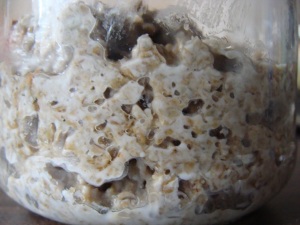 Sourdough starter after one week in the fridge. To get a sourdough starter you could ask in a bakery. Sometimes its available at wholefood or health food shops. Note: There is also sourdough essence available. Its not necessarily applicable as a leavening agent as it is sometimes just sourdough aroma. Alternatively, you can make your own sourdough. To do this grind 100 g rye grains and mix with 100 ml of lukewarm water. Leave in a warm place for fermenting. Stir after 24 hours and add another 100 g of ground rye grains and 100 ml of lukewarm water; repeat after another 24 hours. The sourdough soon develops its typical smell and taste. Depending on the time of the year and the outside temperature the sourdough will need 3 to 7 days to get started. A good climate chamber for the sourdough is the cold oven, where you can put the bowl with the sourdough. In my experience, the sourdough gets better the older it gets. The Detailed VersionI usually bake three loaves at a time as they all fit in the oven together. No matter if I bake one loaf or three loaves, I have to think of starting the procedure once and have to prepare all the ingredients. Only the grinding takes longer for three breads. The dough will only be mixed and baked in a loaf tin, not kneaded and shaped into round loaves. I use a plastic bowl which has a capacity of more than 5 l and which can contain the dough for three loaves maximum. Instead of a plastic bowl you could use a dish of glass or clay, just as you like it. I have been using the same dish for 14 years now and you will notice that when you see it. 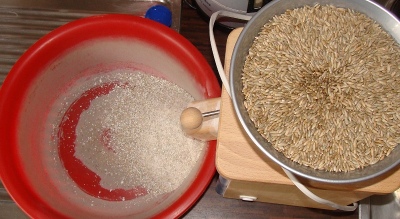
I mix 1300 g of freshly ground rye with just under 1300 ml water and the sourdough starter. I use a wooden spoon for stirring. Usually rye and water have the proportion 1 : 1; the actual amount of water depends on the outside temperature and the air pressure. So please don't pour the whole water into the dough at a time but hold some back and add if necessary. 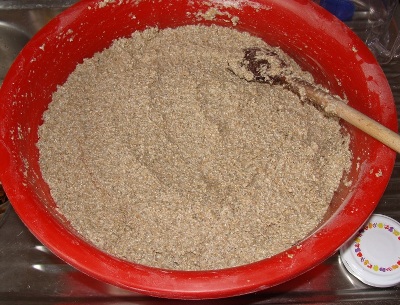
Stir the sourdough well and smooth it out (that reduces the surface area and the loss of moisture) and leave for at least 8 hours. For that, I put the dish in the cold oven. The oven chamber is insulated well and the dough won't dry out as much as elsewhere, and the temperature inside is quite steady. If you let the dough rise at some other place in the kitchen, cover it with a tea-towel. The sourdough should rise by about 40 - 50 %. In winter it could take much longer than 8 hours, as the yeasts are working more slowly. The advantage of this is that it creates finer bubbles in the bread, instead of fewer but larger ones. You don't have to let the sourdough sit overnight. Depending on how much time I schedule for resting I start in the morning if I plan to bake the bread in the evening, or in winter about 24 hours before I want to do the baking. All in all you have to provide 12 to 27 hours for making this bread, but of course there is much spare time in between. 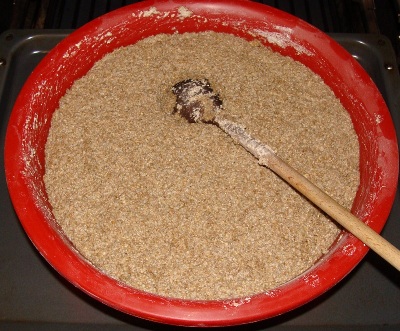
Before you add the second part of grains and the other ingredients, remember to take from the sourdough your starter for the next bread. Grind 1050 g of spelt and add some fennel and coriander to the grains so that the spices are ground too. 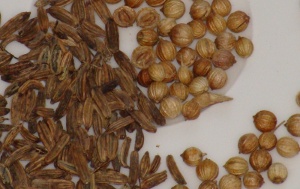
8 tablespoons of sunflower seeds and 8 tablespoons of linseed can be added to your taste. Please don't forget the 3 - 3 1/2 tablespoons of salt. Add the ingredients to the sourdough and blend well. Add as much water as grain. Depending on how dry the sourdough got (dryer in summer than in winter, less dry in the oven than outside), you need to add 750 - 1050 ml of water. 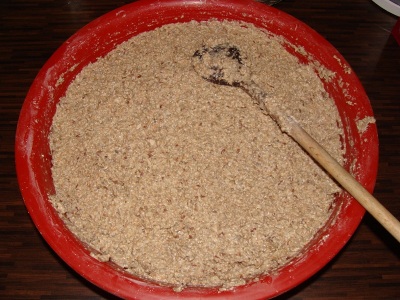 Dough with all ingredients Instead of spelt you could of course use any other grain. With spelt the finished bread tastes milder than for example, with rye. This is the point where you can start experimenting with different sorts of grains. Important: The completely mixed dough should not be too wet. If the dough does not contain enough water the baked bread will be very compact and stirring is quite heavy. If the dough contains too much water it is easy to mix and the loaves look good from the outside, but on the inside they will be sticky and compact and have big holes. If the dough can be stirred without too much effort, it should have the right texture. The final prepared dough must rest for another hour in the bowl before it is mixed again thoroughly for the last time, before the baking tins are prepared. 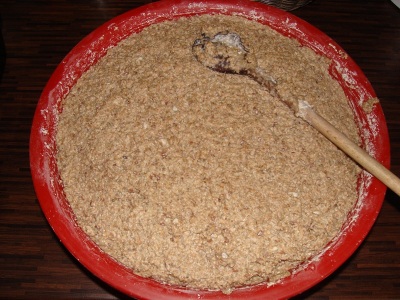 After one hour of rising. I use enameled 30 cm loaf tins for my breads. Attention: Not all baking dishes are suitable for baking at 250°C.Grease the loaf tins with cold margarine up to the top. With warm margarine the grease will be very thin, but its not suitable for the bread dough, as the baked breads like to stick to the baking form. 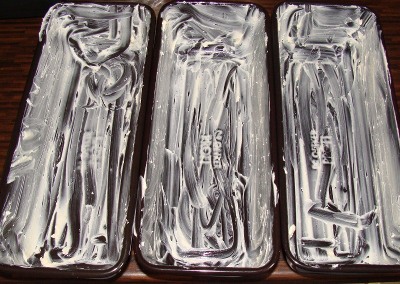
Fill the dough into the prepared loaf tins and flatten the top with the wooden spoon. Then dip the wooden spoon in water and flatten the top again. To do that, I place the now empty dish in the sink and let some water run into it for soaking, then dip the wooden spoon into the water to make it wet. 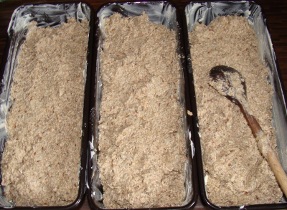
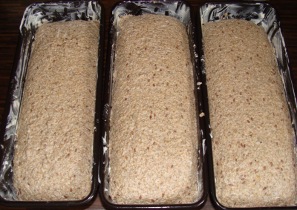 The dough after flattening and planing it with water. Leave the bread dough for another hour. After about 30 minutes I start preparing the oven. Fill a glass with water and place it under the wire shelf on the bottom of the oven. The glass should fit under the wire shelf. You could also use a bowl. Whatever you use for the water - glass or bowl - it will suffer from the heat. It will scale up depending on your water quality and will break after a number of baking passes. So please don't use your favourite glass or bowl for baking bread. Then preheat the oven at 250°C with top and bottom heat. Don't forget to put the glass of water into the oven before you start preheating. If you put the glass of water in the oven when its already hot, it might burst! Why do you need water at all? The steam in the oven is responsible for the crust of the bread after baking! After one hour open the oven carefully, as hot steam will escape, and then you can put the loaf tins on the wire shelf. For the first 15 minutes the bread is baked at 250°C, then turn the oven down to 220°C, baking the breads for another hour. 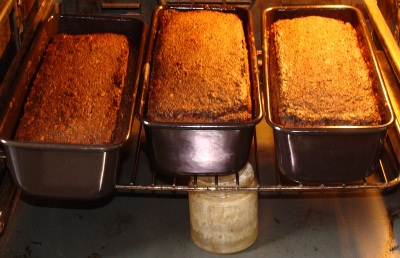
Completely baked breads. Take the loaf tins out the oven and take the loaves out of the tins. Lay them on a board for cooling. Don't use your favourite board as well, as it will suffer from the high temperatures and the moisture from the bread. Even benchtops can only withstand high temperatures for a short time. If you use it often as a cooling board, your benchtop will be damaged. 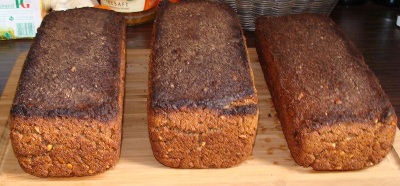
Take the breads for cooling from the loaf tins On the outside the the bread cools down quite quickly, but inside it can take several hours. The warmer it is when you cut it, the stickier it is. Therefore I let the bread cool down for half a day before cutting it. 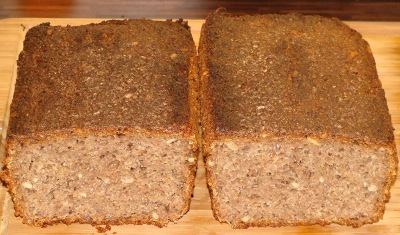
Enjoy your meal! I am well aware that there are several websites about baking bread. But I was asked so often how I do make my bread, that I decided to create a page about it. Time factor of baking breadI was asked several times lately how the laborious task of baking bread can be integrated into everyday life and if I am working.Baking bread is not too laborious if you are used to it. Either you start your sourdough in the morning or in the evening and you can bake your bread(s) respectively in the evening or the next morning. So you could start at breakfast time and finish the bread(s) in the evening about 10 - 12 hours later. Especially baking in the evening is compatible with (most) working times. You just need to remember to grind the right amount of rye for the amount of loafs you want to have in the end, and mix it with the starter and water. In the evening you need about three and a half hours - time you don't need to spend in the kitchen in front of the oven. Grind the grain and stir the dough well. One hours' break. Prepare the loaf tin(s), fill the dough into it (them). After a break of half an hour put the glass of water into the ofen and turn it on to 250°C. Another half hour "off". Put the loaf tin(s) into the ofen, after 15 minutes turn the temperature down to 220°C. After another hour remove the bread from the oven. Done. That leaves enough time for other stuff in the evening. I heard that some people are baking a month's supply of bread in one go in an oven that was especially built for baking. After baking, they put most of the loaves into the freezer. I guess that is another story. I have the feeling that my approach gives me a lot of fresh bread and is socially compatible with everyday life. And yes, I am working and I do take care of household and children. I have been baking this kind of bread since 1996 and I am still enthusiastic about it, and I don't want to change a thing about it. Usually I do bake bread in the evening because because I can arrange my day to my liking even if I am at home that day. The only disadvantage is that I am going to bed hungry, because there is a yummy smell of fresh bread in the air! |